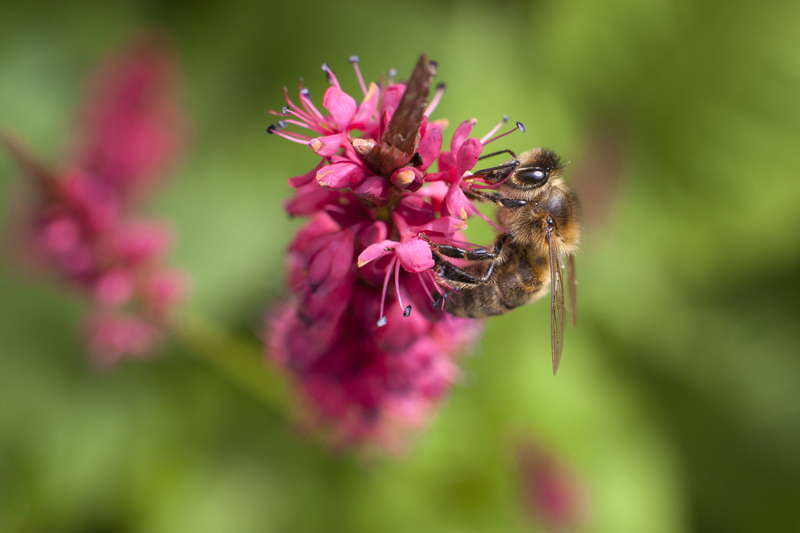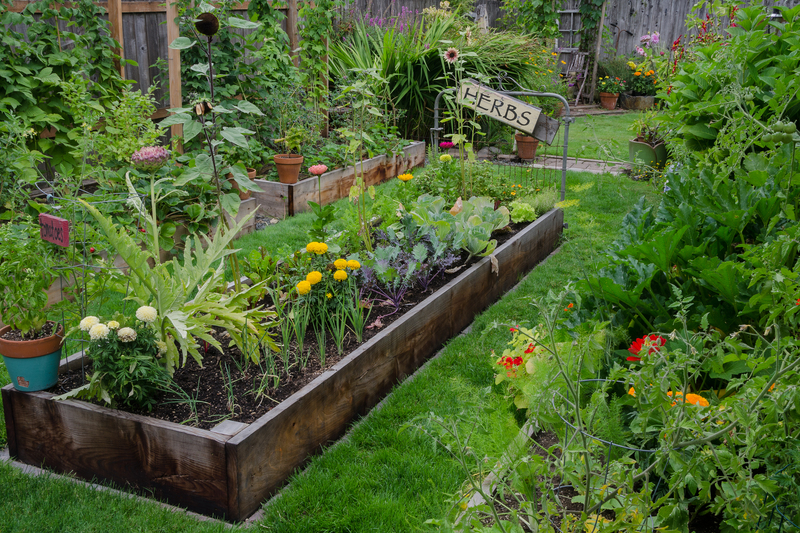Step-by-Step to Your Own Fresh Herb Paradise
Posted on 23/09/2025
Step-by-Step to Your Own Fresh Herb Paradise
Imagine the delight of snipping fragrant basil, peppery arugula, or zesty cilantro right from your kitchen garden -- infusing every meal with vibrant, homegrown flavor. Cultivating a fresh herb paradise isn't just delicious and rewarding; it's also surprisingly easy, adaptable to almost every home, and a sustainable way to savor greens year-round. Follow this detailed, easy-to-understand guide and, in just a few weeks, you'll be harvesting a cornucopia of aromatic herbs!
Why Grow Your Own Herb Garden?
Creating your own fresh herb oasis comes with a plethora of benefits:
- Unmatched flavor: Fresh-picked herbs are more aromatic and potent than store-bought varieties.
- Nutritious and organic: Grow without harmful pesticides and chemicals.
- Cost-effective: Regular harvesting from your own garden is cheaper than buying bundled herbs, most of which end up wilting unused.
- Sustainable living: Reduce packaging waste and carbon footprint associated with transporting commercial herbs.
- Therapeutic and beautiful: Tending greenery enhances wellbeing and adds lush, green beauty to your living space.
Below, we'll walk step-by-step from planning and planting through to caring and cooking with a dizzying variety of culinary herbs. Even a small balcony or sunny windowsill can be transformed into an aromatic herb gardener's retreat.

Step 1: Choose the Right Location for Your Herb Sanctuary
One of the main keys to a truly thriving herb paradise is picking the perfect spot. Here's what to consider:
Indoor vs. Outdoor Herb Gardens
- Indoor herb gardens: Ideal for urban spaces or anyone without an outdoor plot. Choose a sunny windowsill (ideally south- or west-facing) that gets at least 6 hours of sunlight. Supplement with a grow light in darker months or north-facing homes.
- Outdoor herb gardens: Whether in garden beds, balcony containers, or raised garden boxes, most herbs need well-drained soil and at least 6 hours of direct sunlight daily. Some, like mint or chives, will thrive even in partial shade.
Pro Tip: Don't have much space? Try vertical planters, wall-hung pots, railing boxes, or compact tiered shelves for a lush, space-saving herb haven!
Step 2: Select Your Favorite Herbs
Pick herbs you love to use in your cooking and those suited to your climate (or indoor environment). Here are the most popular and easy-to-grow varieties for your fragrant herb oasis:
- Basil: Essential in Italian and Asian cuisine, loves warmth and regular trimming.
- Parsley: Hardy and versatile, with flat-leaf (Italian) and curly varieties.
- Thyme: Perennial, drought-tolerant, adds depth to soups, meats, and breads.
- Rosemary: Fragrant shrub with piney notes, great for roasting and marinades.
- Cilantro (Coriander): Important in Latin and Asian dishes, fast-growing but quick to bolt in heat.
- Mint: Vigorous and invasive when planted in beds, perfect for pots. Delicious in teas, salads, and desserts.
- Dill: Ideal for fish and pickling, likes plenty of sun and well-drained soil.
- Chives: Milder than onions, snip regularly for salads and garnishes.
- Oregano: Robust perennial, classic in Mediterranean dishes.
- Sage: Silvery leaves elevate meats, stuffings, and butter sauces.
Herb tip: Companion planting herbs together often helps deter pests and improves growth! For example, basil planted with tomatoes can help repel insects and enhance flavor.
Step 3: Prepare Containers and Soil
Great soil means great herbs! Whether you're using pots, raised beds, or planting directly in the garden, follow these guidelines for a robust herb garden.
Choosing Containers
- Material: Terracotta, glazed ceramic or food-safe plastic pots work well.
- Drainage: Each pot must have drainage holes to prevent waterlogged roots.
- Size: 6-12" pots for most herbs; deeper and larger for fast-spreading varieties like mint or rosemary.
The Best Soil for Fresh Herbs
- Use a light, well-draining potting mix--herbs do not like soggy roots!
- Mix in a little compost or worm castings for extra nutrition.
- For raised beds or outdoor plots, work in organic matter (compost, leaf mold) to enrich the earth and improve drainage.
Step 4: Planting Your Herb Seeds or Seedlings
You can start your herb heaven from seeds or buy young plants from a nursery. Here's how to do both:
Starting from Seed
- Fill pot or seed tray with your prepared soil mix.
- Sow seeds as directed on the packet -- most need to be barely covered with soil.
- Mist lightly, cover with dome or plastic wrap, and keep consistently moist (not wet) until germination.
- Thin seedlings so the strongest remain, spacing appropriately for the variety.
Using Nursery-Grown Seedlings
- Gently remove from the nursery pot and tease roots apart if pot-bound.
- Plant at the same depth as before, water in well.
- Mulch around outdoor herbs with straw or compost to conserve moisture and suppress weeds.
Step 5: Care and Maintenance for Healthy Herbs
Follow these simple care steps to enjoy a flourishing herb paradise:
- Watering: Most herbs prefer soil that is moist but not soggy. Water when the top inch feels dry.
- Feeding: Feed potted herbs with a half-strength organic liquid fertilizer every 4-6 weeks for continued vigor.
- Sunlight: Ensure 6+ hours of sunlight daily; supplement with lamps if needed indoors.
- Pruning: Regular harvesting encourages bushiness. Never remove more than one-third of the plant at once.
- Pest Control: Pick off insects by hand or spray with diluted organic soap solution if necessary.
- Airflow: Avoid crowding pots and snip off weak or excess stems to improve air circulation--especially important indoors.
Pro Tip: Rotate indoor herb pots every week to ensure even sunlight exposure and prevent legginess.
Step 6: Harvesting Fresh Herbs for Maximum Flavor
Harvesting is the most rewarding part! Follow these tips for abundant yields and continuous regrowth:
- Snip or pinch herbs just above a leaf node to encourage branching.
- Harvest in the morning for the best flavor before the heat of the day drives off aromatic oils.
- For perennial herbs (rosemary, thyme, sage), harvest lightly during the growing season; avoid stripping woody stems.
- Use sharp, clean scissors to minimize damage to the plant.
- If surplus, dry or freeze herbs to preserve their flavor and aroma for later use.
Step 7: Troubleshooting Common Herb Gardening Problems
Even the most attentive gardeners may face a few challenges. Here's how to keep your herbal sanctuary thriving:
Pests & Diseases
- Aphids & Whiteflies: Remove by spraying with water or using neem oil.
- Powdery mildew: Prune to improve airflow, avoid overhead watering, and use natural fungicide if needed.
- Slugs or snails: Collect at night or use organic bait.
Leggy, Weak Growth
- Increase sunlight or move pots to a brighter area.
- Trim regularly to promote bushier plants.
Yellowing or Wilting Leaves
- Typically overwatering or poor drainage--allow soil to dry before watering again.
- Check for root rot and amend soil if needed.
Step 8: Integrate Herbs Into Cooking and Home Life
Now your culinary herb garden is abundant, let's bring its bounty to your dining table and beyond:
- Infuse oils and vinegars with snipped rosemary, basil, or tarragon for gourmet dressings and marinades.
- Make fresh pestos, chimichurri, and herbed butters--perfect for pastas, breads, or topping roasted vegetables.
- Garnish soups and salads with delicate chives, parsley, or dill.
- Brew herbal teas with mint, lemon balm, or thyme for a calming boost.
- Create natural air fresheners or potpourri by drying excess herbs in bundles.
DIY project: Arrange a mini "herb bar" in your kitchen, complete with scissors and labeled jars. Turn everyday meals into a celebration of your own fresh, homegrown flavors!

Step 9: Expanding Your Herb Paradise
Once you're comfortable, consider growing specialized or rare herbs like lemon verbena, stevia, shiso, or edible flowers (nasturtiums, calendula) to add exotic scents and flavors to your garden. Experiment with different containers, companion planting, or succession sowing for a continuous, fresh harvest.
Year-Round Herb Gardening Tips
- Bring tender herbs inside before the first frost, or use row covers and cold frames outdoors.
- Grow microgreens (baby basil, cilantro, arugula) indoors for gourmet winter salads.
- Practice crop rotation and refresh potting soil annually to avoid disease build-up.
Conclusion: Growing Your Fresh Herb Paradise
Cultivating a bountiful herb garden is easier, cheaper, and more rewarding than most people imagine. With a little planning, the right location, and a handful of favorite varieties, anyone can savor the pleasure of fresh herbs at their fingertips all year long. Start small, nurture your plants with care, and savor both the journey and the harvest. Your own fresh herb paradise awaits -- lush, aromatic, and filled with flavor!
Additional Resources
- Royal Horticultural Society: Herb Growing Guides
- University of Minnesota Extension: Growing Herbs
- Gardener's Supply Company: How to Grow Herbs
Start today, and soon you'll be living in your very own fresh herb paradise!

